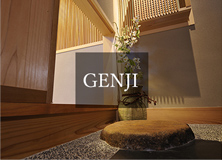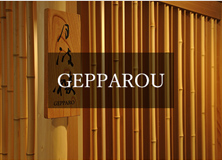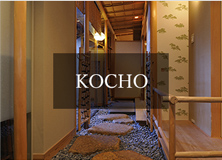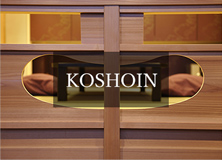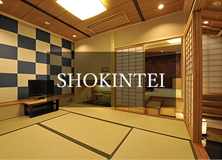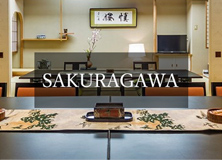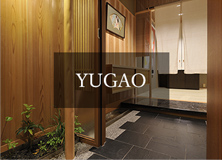
From the gate facing the Rokkaku street continuing on into the main entrance.
From the gate facing the Rokkaku street continuing on into the main entrance, runs a narrow pathway created by craftsmanship of Kyoto style gardener, carpenter, and mason.
You can feel the heart of tea culture here and there.
We hope you will enjoy the Kyoto elegance in each of your steps to the entrance.

- Saji stone
- It is also known as Saji river stone as it is brought from the Saji River in Tottori prefecture. The peculiar shaping made by natural corrosion reminds us of the magnificent landscape. A bit of moss growing, autumn leaves landing on, drops of rain gently moisturing the surface – it is definitely one of the splendid stones of Japan just by quietly sitting there.
- Kurama stone
- 「About mid way past the pathway, are stepping stones made by the Kurama stone brought from Kurama, Kyoto. Kurama stones are the best for stepping stones as they are naturally shaped flat. There are similar stones from other prefectures also named “Kurama stones” but the ones from Kyoto are called “Hon-Kurama” and are very important for creating a traditional Japanese garden.
We recommend you to slowly walk down the pathway to enjoy the changing sceneries.
- Minogaki (straw fence)
- A fence that looks like straws hanging down. Fences in Saga, Sub tower of Tenryu temple, and Hogo-in’s Shishiku garden are famous.
- Kayabuki roof (Thatch roof)
- The Kayabuki roof is at the doorway to the lobby “Suikyo” – it is small, but made very closely to the traditional roof. You can feel the nature of Kyoto from the roof.
- Kanatoro (Gold lanterns)
- A Golden lantern. It is said these elaborately designed lanters were often made until the Edo era, but as it is for outdoor usage, it was easily hurt and lost by wind and rain. Also because the lantern was made from copper, it was gathered and used for war.
The lantern in the pathway is said to be made in the early Edo era.
- Yoroi-kabe (Clincher built wall)
- It is one of the techniques of a plasterer. Instead of placing the boards equally, the shifted boards look like armors – this is the reason of the name. It is also said that the walls are easily dried when it rains.
- Rikyugaki (Imperial bamboo fence)
- A high class bamboo fence. It is originally from the bamboo head fence of the Katsura imperial palace, it is also called as “Katsuragaki”. It is sometimes used for luxury houses but the longest it could get is about few meters. The great fence in the pathway is 10 meters long.
- Naguri board wall
- A board wall made by “naguri” taste cedar wood boards. “Naguri” is a technique of formatting the surface of the board. Instead of shaving the wood smoothly, the surface is carved by hand ax leaving unnnatural and peculiar patterns. Since it is a traditional hand work, the one and only boards add a deeper taste to the wood. These boards are widely used in the faciliy like the pole and handrails.
It is said that the craftsman are getting less and less ove the years, and currently there are only two who can carve the real boards.
- Kamogawa Maguroishi (Kamo river black stone)
- Kamo river’s black stones are often used for the entrance floor. The black color is the characteristic as it is in its name. The deep black color makes the white skin color stand out, so it is sometimes used in bathrooms in the geisha quarter. It is becoming very rare all around Japan.
- Koshikake Machiai (Guest bench)
- This is a bench under roofd which was often set at gates and entrances. In the pathway, it is set as a bench for guests to sit and wait.
The seats are in a row, but the seat on the very left is for the guest of honor. The person is guided to the seat by using the stepping stones to the right and the left. The pole in the back on the left is made from the wood of Kyoto Kitayama. The pole in the front is made from the Naguri boards. Stepping stones are made by the natural Kurama stones of Kyoto. Also, the wall in the back is made from Jurakuheki – one of the famous materials used for reception rooms.
- Saji stone
- It is also known as Saji river stone as it is brought from the Saji River in Tottori prefecture. The peculiar shaping made by natural corrosion reminds us of the magnificent landscape. A bit of moss growing, autumn leaves landing on, drops of rain gently moisturing the surface – it is definitely one of the splendid stones of Japan just by quietly sitting there.
- Kurama stone
- 「About mid way past the pathway, are stepping stones made by the Kurama stone brought from Kurama, Kyoto. Kurama stones are the best for stepping stones as they are naturally shaped flat. There are similar stones from other prefectures also named “Kurama stones” but the ones from Kyoto are called “Hon-Kurama” and are very important for creating a traditional Japanese garden.
We recommend you to slowly walk down the pathway to enjoy the changing sceneries.
- Minogaki (straw fence)
- A fence that looks like straws hanging down. Fences in Saga, Sub tower of Tenryu temple, and Hogo-in’s Shishiku garden are famous.
- Kayabuki roof (Thatch roof)
- The Kayabuki roof is at the doorway to the lobby “Suikyo” – it is small, but made very closely to the traditional roof. You can feel the nature of Kyoto from the roof.
- Kanatoro (Gold lanterns)
- A Golden lantern. It is said these elaborately designed lanters were often made until the Edo era, but as it is for outdoor usage, it was easily hurt and lost by wind and rain. Also because the lantern was made from copper, it was gathered and used for war.
The lantern in the pathway is said to be made in the early Edo era.
- Yoroi-kabe (Clincher built wall)
- It is one of the techniques of a plasterer. Instead of placing the boards equally, the shifted boards look like armors – this is the reason of the name. It is also said that the walls are easily dried when it rains.
- Rikyugaki (Imperial bamboo fence)
- A high class bamboo fence. It is originally from the bamboo head fence of the Katsura imperial palace, it is also called as “Katsuragaki”. It is sometimes used for luxury houses but the longest it could get is about few meters. The great fence in the pathway is 10 meters long.
- Naguri board wall
- A board wall made by “naguri” taste cedar wood boards. “Naguri” is a technique of formatting the surface of the board. Instead of shaving the wood smoothly, the surface is carved by hand ax leaving unnnatural and peculiar patterns. Since it is a traditional hand work, the one and only boards add a deeper taste to the wood. These boards are widely used in the faciliy like the pole and handrails.
It is said that the craftsman are getting less and less ove the years, and currently there are only two who can carve the real boards.
- Kamogawa Maguroishi (Kamo river black stone)
- Kamo river’s black stones are often used for the entrance floor. The black color is the characteristic as it is in its name. The deep black color makes the white skin color stand out, so it is sometimes used in bathrooms in the geisha quarter. It is becoming very rare all around Japan.
- Koshikake Machiai (Guest bench)
- This is a bench under roofd which was often set at gates and entrances. In the pathway, it is set as a bench for guests to sit and wait.
The seats are in a row, but the seat on the very left is for the guest of honor. The person is guided to the seat by using the stepping stones to the right and the left. The pole in the back on the left is made from the wood of Kyoto Kitayama. The pole in the front is made from the Naguri boards. Stepping stones are made by the natural Kurama stones of Kyoto. Also, the wall in the back is made from Jurakuheki – one of the famous materials used for reception rooms.
There are still many view points which could not be covered.
We hope you will enjoy all the details when you visit the pathway.




